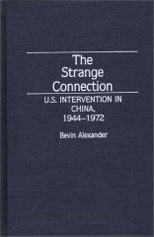 Click here to purchase from Barnes & Noble.
Click here to purchase from Amazon.com.
Click here to purchase from Barnes & Noble.
Click here to purchase from Amazon.com.
Destruction of the Chinese Red Regime Becomes U.S. Policy
Excerpt from The Strange Connection: U.S. Intervention in China, 1944-1972, by Bevin Alexander, pages 142-43
The American decision to adopt destruction of the Chinese Communist state as national policy emerged clearly on November 4, 1953. Robert R. Bowie, director of the State Department’s policy-planning staff, was discussing NSC [National Security Council] 166, “U.S. Policy toward Communist China,” with Walter Bedell Smith, General Eisenhower’s chief of staff during World War II and now undersecretary of state. Bowie told Smith the Joints Chiefs of Staff wanted NSC 166 amended to set forth definitely that the “ultimate objective of the U.S. is the replacement of the Chinese Communist regime by one which, as a minimum, would not be hostile to the United States.”
Bowie said such an objective was beyond U.S. capabilities. General Smith replied such a resolve “was merely a statement of the obvious” and he didn’t see any harm in making it national policy. “We could agree to repeating it over and over,” Smith said, “just as the Romans made a watchword of Carthago delenda est [ Carthage must be destroyed].” Smith said he could understand why the Joint Chiefs wanted to state a “high objective which seemed beyond our immediate capabilities.”
The next day Smith explained his reasoning to the National Security Council, repeating Carthego delenda est and saying destruction of the Red Chinese regime should be the long-range objective of the United States. Though President Eisenhower teased Smith by saying it was unfair to quote Latin to him when he was already suffering from a severe head cold, he agreed and the council adopted the proposal.
<< More 'Cold War' Excerpts << Back to top